full article:
Introduction
Diabetes is one of the top 10 causes of death in the USA1. The American Diabetes Association estimates that 7.8% of the US population has the disease2. Moreover, diabetes prevalence rates in the USA, especially for type 2 diabetes, are growing2. For example, the Centers for Disease Control and Prevention indicate that the incidence has grown from 5.7 million in 1982 to 17.9 million in 2007. As diabetes incidence continues to rise, this challenging problem will require increased attention for early identification and optimal management.
Negative health outcomes are often associated with, among other things, race, poverty, and inadequate access to health care3-5. Increased diabetes prevalence has been associated with higher levels of poverty6-8, and some minority populations appear to be at greater risk for developing diabetes1. Diabetes incidence also has a geographic dimension. While few epidemiological studies have assessed variations in diabetes prevalence and care between urban and rural areas, rural populations have been known to have a higher incidence of type 2 diabetes, independent of race9. Nationally, differences have been found in diabetes care when comparing rural with urban US populations, within and across states and by region10.
Appalachia is a relatively rural area historically plagued by high poverty rates, elevated incidence of some diseases, and relatively inadequate levels of health care11-17. At the time this study was conducted, the region, as politically defined, included all of West Virginia and parts of 12 other states, or a total of 410 counties (Fig1)16. Appalachia can be understood as the only multi-state US region ever targeted by the federal government for a specific development program designed to improve socioeconomic conditions14,16. Despite these efforts, which have included projects ranging from building highways to job training programs, problems persist, particularly in the rural parts of the region. In states such as Kentucky, Ohio, West Virginia, and Mississippi, relatively large pockets of rural areas lag behind much of the nation in levels of income, employment, educational attainment, and poverty(Fig1)12,16,18. Additionally, rural areas of Appalachia have historically had inadequate numbers of healthcare professionals, types of health service delivery options, and have experienced disproportionately high morbidity rates for some diseases, relative to much of the nation11,13,14.
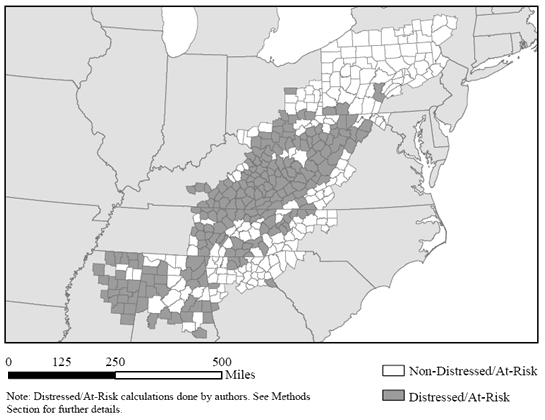
Figure 1: Historically distressed/ at-risk counties in Appalachia.
Research suggests that diabetes rates are relatively high in Appalachia, especially in the region's rural, economically 'distressed' areas. Three studies conducted by the Appalachian Rural Health Institute (ARHI) have been tracking the diabetes rates in Appalachian Ohio counties. The ARHI I study, a random telephone survey based upon a modified Behavioral Risk Surveillance Survey (BRFSS) conducted in 4 Appalachian Ohio counties during December 2003, found that 8.3% of the surveyed population had diabetes, a rate approximately one-third higher than the national average at the time19. A similar ARHI II 2006 follow-up study in 7 other Appalachian Ohio counties identified a diabetes prevalence rate of 11.3%, which was also higher than national and state averages20. The latest ARHI III study, initiated in late fall 2008 with 9 different Ohio counties, found the diabetes rate to be 12.5%, which exceeds the Ohio (9.5%) and the national (8.6%) 2007 BRFSS rates. Research not only indicates that diabetes is a relatively profound problem in parts of Appalachia, but over the past few years the disease incidence in some parts of the region has been growing faster than the national average2,19,20.
Overall, it is important to recognize that life experiences can differ dramatically not only across the region, but also within individual communities. While residents of some urban Appalachian areas have access to numbers of healthcare professionals and specialists reflective of or better than national averages, in the more impoverished, rural parts of the region healthcare practitioner shortages have existed for decades11,13,14,21. Similar to the circumstances throughout much of rural America, however, many individuals, particularly in Appalachia's economically distressed areas, lack adequate transportation to access distant healthcare options, lack health insurance, and have limited opportunities for jobs that provide health insurance22-24. Similarly, modifiable risk factors such as obesity, tobacco use, and physical activity levels have been strongly associated with health problems for some members of the population, as has a lack of trust in healthcare providers and limited healthcare knowledge25.
The status of health systems and professional expertise available to address the diabetes epidemic, whether in Appalachia or elsewhere, is poorly understood. The long-standing problems of personal health and access to healthcare services in much of Appalachia, along with the context of growing diabetes rates in some parts of the region, are of concern. Moreover, research indicates that residents of rural areas have unique diabetes care needs and risks26. For example, the 2006 Behavioral Risk factor Surveillance Survey for Virginia identified that:
- 30.4% of Appalachians were obese, compared with 24.6% of non-Appalachians
- 35.5% of Appalachians had high blood pressure, compared with 30.1% of non-Appalachians
- 44.3% of Appalachians had high cholesterol, compared with 39.7% of non-Appalachians.
This report indicated that the rate of diabetes for those in the Appalachian counties was 11%, compared with 7.2% in the non-Appalachian counties. Additionally, the latest ARHI III study conducted in 11 Appalachian Ohio counties found that in individuals with a diabetes diagnosis, the rate of diagnosis before the age of 40 years was 49.2%, substantially higher than 19% in those younger than 40 years, found in the 2008 National Health Interview Survey.
This present study explored the availability and disparities of diabetes healthcare professionals in relation to geographic and socioeconomic circumstances in the Appalachian region. The primary purpose for this exploratory research was to examine the availability and types of professional diabetes care provided in Appalachia, comparing economically distressed and non-distressed rural counties.
Methods
A cross-sectional survey of healthcare providers in the Appalachian Region was conducted during winter 2006. In general, the intention of the survey was to examine issues such as the types of healthcare practitioners involved with diabetes care, services available, and levels of diabetes needs in the Appalachian region, including cross-location comparisons. Experts, specifically diabetes educators and care providers, were consulted during the initial development of the survey instrument. A pilot survey, drawing on expertise of 30 diabetes educators and care providers, was conducted to assess matters such as the content validity of survey questions. Based on its initial design and related feedback, the final survey included questions about types of health organizations represented, health professionals employed in surveyed facilities, the characteristics of diabetes patients, forms of diabetes education and treatments provided, and community demographics. The Institutional Review Board from Ohio University's Office of Research and Sponsored Programs approved the study protocol and survey data collection methods described.
Surveys were mailed to all health departments (HD), Federally Qualified Health Centers (FQHC), and certified diabetes educators (CDE) who could be identified in an exhaustive search of internet-based resources. A letter accompanying the surveys sent to the HD and FQHCs asked for the person most knowledgeable about diabetes at the facility to complete the survey, while those sent to the CDEs simply asked that they complete the survey. All mailings included an informed consent form and a stamped, return-addressed envelope. Based on financial resource limitations, the research design included only one mailing. As discussed will be discussed, this did not appear to introduce a bias that would affect the interpretation of survey results.
In all, a total of 850 surveys were mailed; a total of 197 surveys were returned, but only 182 surveys were fully completed and used in this analysis. Thus, the total return rate of surveys was 23.2% with 21.4% useable surveys. Many FQHC sites received multiple surveys, but completed only one. For example, several FQHC sites had multiple sites (n = 43) where 2 to 12 agencies were affiliated. At least one survey was returned from 17 or 39.53% of these multi-sites. Data about the region came from 152 of the then 410 Appalachian counties (Table 1). No surveys were returned from FQHC in Alabama, none of the HD in Maryland returned surveys, and no CDE surveys were returned from the states of Maryland or Mississippi. Because the survey involved only a single mailing, the response rate can be seen as reasonable. Moreover, and as indicated in Table 1, the returned surveys can be understood as sufficiently representative of the population at large.
Table 1: Overview of returned surveys
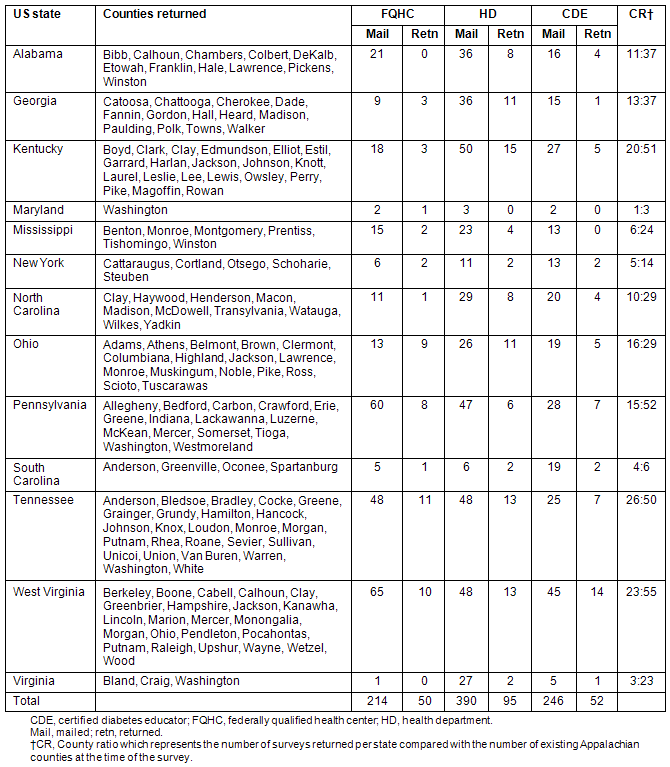
Survey data were entered into SPSS (www.spss.com) and response information from each facility was linked with information about the socioeconomic status of the county where the facility was located. To gauge socioeconomic status, this analysis used a measure that the Appalachian Regional Commission (ARC) utilizes to identify areas to target its development resources27. This ARC economic distress measure is similar to criteria used by other federal and state agencies for similar purposes28. Specifically, the ARC identifies any individual county in the Appalachia as meeting one of 5 economic designations: distressed, at-risk, transitional, competitive, or attainment. Designations are based on individual county-level economic indicators, particularly in relation to levels of unemployment, poverty, and income27.
At the time of this analysis, the ARC considered a county to be distressed if it met the following criteria: a poverty rate at least 1.5 times the national average, an unemployment rate (three-year average) at least 1.5 times the national average, and per capita market income (PCMI, which is income less transfer payments) no more than two-thirds of the national average. A county could qualify as distressed if it had poverty rates at least twice the national average and met one of the remaining two criteria. The ARC understands at-risk counties to be borderline economically distressed, those with unemployment rates at least 1.25% of the national average, PCMI no greater than two-thirds the national average, and poverty rates at least 1.25 times the national average. Counties also qualify as 'at-risk' if they meet two of the three distressed criteria. In short, when compared with the rest of the nation and much of Appalachia, many counties currently considered distressed or at-risk by the ARC have had inferior economic conditions for decades16.
As a means to identify counties with historically poor economic conditions, and because short-term fluctuations occur in county-level economic circumstances, this research used historical data were primarily drawn from the census to determine counties that met the ARC's distressed or at-risk criteria for extended time periods. Based on the authors' calculations (because the ARC has only measured economic distress since the mid-1980s) counties were classified as being 'distressed/at-risk' if they met the equivalent of either the ARC's distressed or at-risk criteria in at least 4 of the 5 previous decennial census years (1960, 1970, 1980, 1990 and 2000). Of the 182 survey responses, 82 came from facilities that met the criteria for distressed/at-risk. Thus, these responses represent distressed/at-risk counties, while the remaining 100 responses correspond to non-distressed/at-risk counties.
Information is provided about the geographic and socioeconomic conditions for the distressed/at-risk and non-distressed/at-risk counties where facilities included in this analysis were located (Table 2). Major differences in socioeconomic circumstances exist not only between the distressed/at-risk counties and non-distressed/at-risk counties in this analysis, but also between the distressed/at-risk counties and US averages. Poverty, unemployment, educational attainment, and income levels in the distressed/at-risk counties all compare unfavorably with national averages. Distressed/at-risk areas also have exceptionally low levels of urbanization. Another issue is that the socioeconomic conditions in the non-distressed/at-risk Appalachian counties in this analysis compared favorably with not only the distressed/at-risk counties, but also with the nation as a whole (Table 2). Belying notions that Appalachia is homogeneous in terms of socioeconomic conditions, these non-distressed/at-risk counties have relatively high levels of urbanization and relatively strong economic conditions. It is of note that survey responses were, in general, proportionately representative of the number of distressed/at-risk and non-distressed/at-risk counties in the region.
Table 2: Median county-level socioeconomic characteristics by location
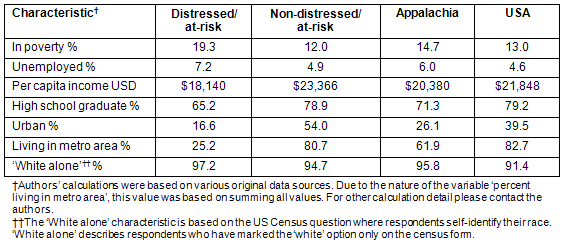
To evaluate diabetes service availability in Appalachia, statistical analyses were performed in relation to the dichotomized distressed/at-risk status variable. As suggested, survey questions addressed a number of issues related to perception of diabetes incidence and care. Statistical analyses examined respondent perceptions about the growth of diabetes incidence locally; estimated number of diabetic persons seen weekly where the respondent was affiliated; and the types of healthcare practitioners, including endocrinologists and certified diabetes educators, employed.
Crosstabs of categorical variables were developed and χ2 tests used to test for independence of variables were completed. Significance in the associations between distressed/at-risk location and the perceived growth of diabetes incidence as well as the estimated number of diabetes patients seen weekly were tested with Pearson's χ2 test. Due to low expected values for some cells in the tables and related unequal cell distribution, Fisher's exact tests were used to test for statistically significant differences between healthcare professional availability and location. One-way statistical tests were utilized with the assumption that the non-distressed/at-risk locations would be more likely to have specialized healthcare professionals when compared with distressed/at-risk locations. For all analyses, tests with p-values of less than 0.05 were considered statistically significant. As is typical with survey research, the number could vary slightly in relation to any individual question due to issues such as non-response or the applicability of questions to some respondents.
A qualitative assessment of the final survey question is also presented in this article as a means to provide additional clarification of the findings. The final item invited participants to provide a short answer response to the following question: 'If you could change anything in your organization or community pertaining to the care of persons with or at risk of type 2 diabetes, what would it be?' Content analysis of the responses to this question was completed and thematic responses identified. Based on the utilization of enumeration and coding techniques that are typical in qualitative data analysis, the results section provides an overview of common themes identified in the responses.
Results
Nearly all respondents perceived there had been a growth in type 2 diabetes over the past 5 years (Table 3). About one-third of the respondents believed that the numbers of people with type 1 diabetes had also increased, though the majority reported stable numbers for type 1 diabetes. Corresponding with the perception that type 2 diabetes prevalence had increased were the observations that the number of children diagnosed with type 2 diabetes and individuals with undiagnosed diabetes were increased when compared with 5 years earlier. All trends were similar across distressed-at risk as well as in non-distressed at risk locations, with no statistically significant differences in perceptions of diabetes prevalence when comparing these 2 types of locations.
Table 3: Trends in number of persons with diabetes in community
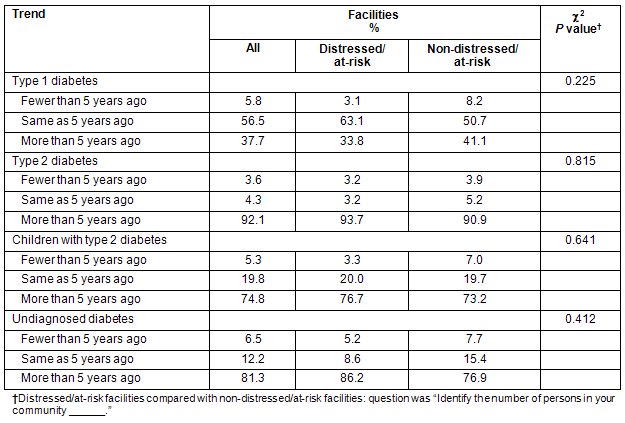
Slightly more than one-quarter of the respondents reported that their facilities were seeing more than 20 patients with diabetes weekly (Table 4). A higher percentage from distressed/at-risk locations indicated that they saw more than 20 patients with diabetes weekly. Similarly, a higher percentage of respondents from these facilities indicated that they saw fewer than 5 diabetic patients weekly. However, no statistically significant differences in the estimated number of persons diagnosed with diabetes seen weekly were observed by location.
Table 4: Estimated number of persons diagnosed with diabetes seen weekly

As indicated, most indicated that healthcare facilities did not employ specialists important to diabetes care (Table 5). Slightly more than one-third of the facilities employed a CDE, while only approximately one-third employed non-certified diabetes educators. More than 85% of the facilities did not employ an endocrinologist. While facilities in distressed/at-risk areas were as likely as facilities in non-distressed/at-risk areas to employ medical professionals such as full-time physicians and nurses, they were less likely to employ specialists vital to the care of diabetes. Endocrinologists and CDEs were statistically significantly less likely to be employed in facilities located in distressed/at-risk areas, compared with facilities in non-distressed/at-risk areas. A total of 7.5% and 24.3% of the facilities in distressed/at-risk locations employed endocrinologists and CDEs, respectively. Fewer than 20% of facilities in the non-distressed/at-risk facilities employed endocrinologists, and less than half of the facilities employed CDEs.
The lack of diabetes specialists in the region is especially apparent when taking into account absolute numbers. For example, only 5 of 67 of facilities in distressed/at-risk locations, and only 15 of 82 facilities in non-distressed/at-risk locations, employed endocrinologists. Only 2 of 21 facilities in distressed/at-risk locations that were seeing more than 20 diabetic patients a week were employing an endocrinologist, while only 5 of 21 facilities in non-distressed/at-risk locations seeing more than 20 diabetic patients a week employed an endocrinologist.
Table 5: Healthcare practitioners employed by location
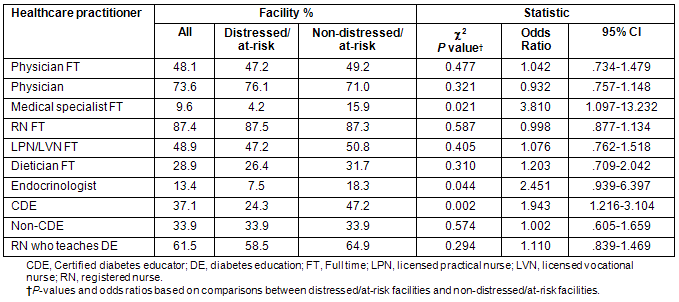
The final question on the survey asked respondents to provide comments about specific needs or areas they believed needed attention regarding diabetes care in their community. While some participants failed to answer this question, about three-fourths of them provided some response and the comments made were similar across all participant groups (ie CDEs, FQHC, HDs). Of those who responded, most were concerned with the inadequacy of diabetes care provided. These participants often noted issues such as the lack of early diagnosis, difficulties in specialist referrals, and problems with poorly coordinated care between hospitals, community, and home settings. Lack of diabetes educators, availability of dieticians or nutritionists, and enough endocrinologists was most often cited as a need, regardless of whether the area was a distressed or non-distressed county.
Respondents who made written comments from FQHC and HDs were most likely to note needs for nurses and physicians who were more knowledgeable about diabetes and the care standards. approximately half of the responding HD participants from all Appalachian regions identified that diabetes education was most often provided by registered nurses who were often ill-prepared with current treatment knowledge. Approximately one-quarter of the participants reported that little to no attention to diabetes occurred in their counties, and that specialists who could provide any type of prevention or diabetes self-management education were lacking.
Of the respondents, approximately half of the CDEs, half of those from HDs, and about one-third of the FQHC participants indicated concerns about diabetes self-management, prevention, and the inadequate information physicians gave to those diagnosed with diabetes. For example, one HD participant said physicians need to 'stop telling patients they are "borderline" and give them meal and exercise plans to prevent getting diabetes'. Similarly, a concern raised by these CDEs and HD participants pertained to physician, patient, and community misunderstandings about insulin treatment. One CDE said:
Often times, patients are newly diagnosed with type 2 diabetes, given prescription for medications or insulin and sent home with little or no education. Many patients have the misconception that if they 'stay away from sweets' that they are managing their disease.
Other problems mentioned often included needs for early referral to formal diabetes education classes, better and more comprehensive community prevention efforts, and healthy lifestyle management. A few participants from all three groups indicated that increased interdisciplinary education for inpatients and ongoing diabetes education for those already encountering complications was needed. A few from FQHCs and HDs specifically noted a lack of adequate facility space for education, inadequate care continuity, and limited teaching resources. Approximately one-third of the responding participants from all groups indicated that inadequate reimbursement for diabetes education and prevention programs were reasons for the lack of appropriate care services availability.
All participant groups identified concerns about lack of health insurance or under-insured individuals. One health department participant summarized what most participants responding to this question indicated:
We lost funding for our diabetes program several years ago. We have three clients that we continue to provide services for because we were unable to find an alternative source for meds. These patients are managed by private MDs. The patients cannot afford to buy insulin. We have no hospital, few MDs here and the closest care is 30 miles away. Transportation is always an issue.
Responses from the majority of participants indicated that many diagnosed with diabetes did not receive diabetes education, had no or inadequate coverage for self-management supplies, and lacked needed finances for follow-up medical care.
Discussion
This research was designed primarily to identify providers' perceptions of the prevalence of diabetes and the availability of healthcare professionals involved with diabetes care at healthcare facilities located in Appalachia. Combining survey-based primary data with secondary data offered the opportunity to scrutinize such service availability based on socioeconomic conditions. Survey results suggest that providers perceived an increase in type 2 diabetes prevalence in Appalachia over the last 5 years. This perception is supported by national survey data that indicates diabetes prevalence rates are rising2.
Amidst growth in numbers of people with type 2 diabetes, availability of diabetes specialists is limited in Appalachia, with relatively greater shortages found in distressed/at-risk areas of the region. In short, at a time when diabetes rates are growing rapidly, and in a region where research has demonstrated that diabetes is apparently growing at a rate faster than the national average19,20, the study participants perceived that the adequacy of diabetes expertise was limited in the facilities where they were employed. When access to expert diabetes care is lacking, persons with diabetes may be referred to a specialist in another county, but while specialists might assist with diabetes management, few are engaged in prevention efforts. Therefore, innovative solutions to the growing diabetes related problems are needed to address unique county needs.
A number of limitations related to this study should be noted. First, exploratory findings from the use of a self-report instrument without established reliability and validity is always open for scrutiny. Thus, it should be noted that the perceptions reported may not be broadly representative. Second, persons completing the instruments from a single healthcare facility may be unaware of other care services and needs in the wider community. Third, limited funding for this study did not allow for additional follow up that might have increased the number of surveys returned. However, study participants represented data analysis from 37.1% of the Appalachian counties at the time of the study, with responses from an almost equal number of participants from distressed and non-distressed counties.
This research has demonstrated that age-adjusted mortality is worse in rural areas with physician shortages29. Similarly, diabetes research demonstrates that physicians in rural areas are less likely to follow the American Diabetes Association standards of care30,31, reduced provider monitoring of patient self-care results in relatively poor diabetes outcomes32 and rural residents are more likely to receive care from primary providers than from diabetes specialists33. The present research identified similar trends. A long history of difficulties associated with attracting specialized healthcare professionals to the rural and economically distressed areas of the Appalachian region suggests the importance of local healthcare practitioners' current knowledge about the best evidence for diabetes prevention and self-management.
Findings also indicated that insufficient staffing and facilities for diabetes care may not be a problem that plagues rural, economically distressed areas of Appalachia alone. While statistically significant differences in the availability of diabetes specialists were demonstrated when comparing distressed/at-risk locations with non-distressed/at-risk locations, it was nonetheless apparent that many facilities in non-distressed/at-risk locations had similar problems. A reasonable question is: Are things worse in Appalachia when compared with the rest of the USA, or is Appalachia reflective of the USA as a whole? Shortages of diabetes specialists are prevalent throughout much of Appalachia, regardless of socioeconomic conditions. Amidst concerns about low levels of diabetes specialists in distressed/at-risk locations, circumstances are only marginally better in Appalachia's non-distressed/at-risk locations. However, most persons diagnosed with diabetes do not immediately seek care from an endocrinologist or other specialist and often only seek this care when disease complications occur. However, access to expert primary care clinicians knowledgeable about diabetes is of utmost importance. Finding better ways to address the existing care gaps in Appalachian communities is essential. Closer examination of the effectiveness of community programs, volunteer involvement, and citizen action that focuses on diabetes prevention could all be useful.
Study participants' qualitative responses provide specific information that assists understanding of the specific care deficits linked with diabetes in the region. Studies have found that a lack of monitoring diabetes patients' self-care, low compliance with standards of care, and low utilization of diabetes specialists all affect diabetes patient outcomes in rural areas30,32,33. However, inadequate diabetes care coordination, challenges in diagnosis and care management, and delayed care for uninsured or underinsured individuals suggests that a broad approach to problems is needed. For example, pre-professional and continuing education for health professionals must address ways to fill diabetes care gaps. An interdisciplinary coordinated council to address diabetes and its associated risks could address unique county problems. Involvement of local citizens in volunteer work could be useful in drawing attention to healthy lifestyles and diabetes prevention. It seems essential that health professionals in the Appalachian region pay close attention to local concerns and find ways to collaborate in order to deliver appropriate and timely coordinated diabetes care that includes early diagnosis, optimal care management, and improved care outcomes.
It was noted earlier that Appalachian populations might be at as great a risk for type 2 diabetes as other national high-risk groups. Inadequate coordinated medical care could mean that too little care is provided, or that care is provided too late to prevent the disease or extensive co-morbidities, higher medical costs, and earlier mortality. Greater attention is needed for the uninsured or underinsured population that needs earlier medical diagnosis and appropriate self-management education. Greater diabetes awareness and its linked risk factors are public health concerns and greater attention from local health departments seems warranted. Increased diabetes risks beg for innovative solutions to problems that will not be easily or quickly resolved.
Acknowledgements
This project was supported in part by the Centers for Disease Control and Prevention National Diabetes Education Program, the Ohio Department of Health Diabetes Prevention and Control Program, Ohio University's Diabetes Research Institute, the Appalachian Rural Health Institute, the Diabetes Center, the College of Health and Human Services, and the School of Nursing. Graduate assistants who assisted with this project were Tara O'Brien, Cara Butcher, Stacey Hartman, Tammy Collier, Eimi Lev, and Patricia Harris.
References
1. Centers for Disease Control and Prevention. National diabetes fact sheet: General information and national estimates on diabetes in the United States, 2005. Atlanta, GA: US Department of Health and Human Services, Centers for Disease Control and Prevention, 2005.
2. American Diabetes Association. Total prevalence of diabetes & pre-diabetes. (Online) 2007. Available: http://www.diabetesarchive.net/diabetes-statistics/prevalence.jsp (Accessed 3 May 2010).
3. Jack L Jr. Thinking aloud about poverty and health in rural Mississippi. Prevention and Chronic Disease 2007; 4(3): A71.
4. Kaplan GA, Pamuk ER, Lynch JW, Cohen RD, Balfour JL. Inequality in income and mortality in the United States: analysis of mortality and potential pathways. BMJ 1996; 312(7037): 999-1003.
5. Kaplan GA, Baltrus PT, Raghunathan TE. The shape of health to come: prospective study of the determinants of 30-year health trajectories in the Alameda County Study. International Journal of Epidemiology 2007; 36(3): 542-548.
6. Ismail AA BN, Gill GV, Bellis MA. Capture-recapture-adjusted prevalence rates of type 2 diabetes are related to social deprivation. Quarterly Journal of Medicine 1999; 92(12): 707-710.
7. Robbins JM, Zhang H, Kasl SV. Socioeconomic status and type 2 diabetes in African American and non-Hispanic white women and men: evidence from the Third National Health and Nutrition Examination Survey. American Journal of Public Health 2001; 91(1): 76-83.
8. Connolly V, Sherriff P, Bilous R, Kelly W. Diabetes prevalence and socioeconomic status: a population based study showing increased prevalence of type 2 diabetes mellitus in deprived areas. Journal of Epidemiology and Community Health 2000; 54: 173-177.
9. Mainous AG, King DE, Garr DR, Pearson WS. Race, rural residence, and control of diabetes and hypertension. Annals of Family Medicine 2004; 2(6): 563-568.
10. Weingarten JP, Brittman S, Hu W, Przybyszewski C, Hammond JM, FitzGerald D. The state of diabetes care provided to Medicare beneficiaries living in rural America. Journal of Rural Health 2006; 22(4): 351-358.
11. Appalachian Regional Commission. The first years of the Appalachian Health Program: an interim evaluation. Washington, DC: Appalachian Regional Commission, 1970.
12. Billings D, Tickamyer T. Uneven development in Appalachia. In: T Lyson, WW Falk, KS Lawrence (Eds). Forgotten places: uneven development in rural America. Lawrence, KS: University Press of Kansas,1993; 7-29.
13. Halverson JA, Harner EJ. An analysis of disparities in health status and access to health care in the Appalachian region. (Online) 2004. Available: http://www.arc.gov/research/researchreportdetails.asp?REPORT_ID=82 (Accessed 3 May 2010).
14. President's Appalachian Regional Commission. Appalachia: a Report by the President's Appalachian Regional Commission. Washington DC: US Government Printing Office, 1964.
15. US Congress. Appalachian Regional Development Act of 1965 (Public Law 89-4). Washington, DC: US Government Printing Office, 1965.
16. Wood LE. Trends in national and regional economic distress: 1960-2000. (Online) 2005. Available: http://www.arc.gov/images/aboutarc/grants/pdf/trends_final_05.pdf (Accessed 3 July 2007).
17. Appalachian Regional Commission. The Appalachian Regional Commission Annual Report 2004. Washington, DC: Appalachian Regional Commission, 2004.
18. Wood LE, Bischak G. Progress and challenges in reducing economic distress in Appalachia: an analysis of national and regional trends since 1960. Washington, DC: The Appalachian Regional Commission, 2000.
19. Appalachian Rural Health Institute. Prevalence of diabetes. (Online) 2004. Available: http://www.oucom.ohiou.edu/arhi/presentations/DiabetesFactors.pdf (Accessed 3 May 2010).
20. Appalachian Rural Health Institute. Diabetes. (Online) 2006. Available: http://www.oucom.ohiou.edu/arhi/presentations/Diabetes_06_Final.pdf (Accessed 3 May 2010).
21. Huttlinger K, Schaller-Ayers J, Kenny B, Ayers J. Research and collaboration in rural community health. Online Journal of Rural Nursing and Health Care 2004; 4(1): 22-36. Available: http://www.rno.org/journal/index.php/online-journal/article/viewFile/126/124 (Accessed 3 May 2010).
22. Denham SA. Family health in a rural Appalachian Ohio county. Journal of Appalachian Studies 1995; 2(2): 299-310.
23. Duncan C. Worlds apart: why poverty persists in rural America. New Haven, CT: Yale University Press, 1999.
24. Lichter DT, Johnson KM. The changing spatial concentration of America's rural poor population. (Online) 2006. Available: http://www.npc.umich.edu/publications/u/working_paper06-33.pdf (Accessed 3 July 2007).
25. Coyne CA, Demian-Popescu C, Friend D. Social and cultural factors influencing health in southern West Virginia: a qualitative study. Prevention and Chronic Disease 2006; 3(4): A124.
26. O'Brien T, Denham SA. Diabetes care and education in rural regions. Diabetes Education 2008; 34(2): 334-347.
27. Appalachian Regional Commission. County economic status designations in the Appalachian region fiscal year 2006. (Online) 2006. Available: http://www.arc.gov/reports/custom_report.asp?REPORT_ID=25 (Accessed 3 May 2010).
28. Fullenbaum R, McNeill M. Survey and comparison of distressed area definitions. Washington, DC: Appalachian Regional Commission, 1995.
29. Pathman DE, Fryer GE, Green LA, Phillips RL. Changes in age-adjusted mortality rates and disparities for rural physician shortage areas staffed by the National Health Service Corps: 1984-1998. Journal of Rural Health 2005; 21(3): 214-220.
30. Zoorob RJ, Mainous AG III. Practice patterns of rural family physicians based on the American Diabetes Association standards of care. Journal of Community Health 1996; 21(3): 175-182.
31. Bell RA, Camacho F, Goonan K, Duren-Winfield V, Anderson RT, Konen JC et al. Quality of diabetes care among low-income patients in North Carolina. American Journal of Preventive Medicine 2001; 21(2): 124-131.
32. Anderson RT, Balkrishnan R, Camacho F, Bell R, Duren-Winfield V, Goff D. Patient-centered outcomes of diabetes self-care. Associations with satisfaction and general health in a community clinic setting. North Carolina Medical Journal 2003; 64(2): 58-65.
33. Bell RA, Quandt SA, Arcury TA, Snively BM, Stafford JM, Smith SL, Skelly AH. Primary and specialty medical care among ethnically diverse, older rural adults with type 2 diabetes: the ELDER Diabetes Study. Journal of Rural Health 2005; 21(3): 198-205.


